
House dust mite allergy and treatments
The prevalence of allergic asthma, the most common allergic disease, increased dramatically in the last 20 years. This exacerbated immune-mediated disorder is characterized by chronic airway inflammation, mucus production, and variable airflow obstruction with airways hyperresponsiveness (AHR). House dust mites (HDM) can be considered as one of the most important provider of inhalant allergens within the world and the mite sensitization affects more than 20% of the population from industrialized countries, including Thailand.As it is clearly established that allergen-specific Th2 cells play the central role for the mediation of this chronic inflammatory response, the aim of a vaccine against HDM allergy could be the induction of allergen-specific Th1 or Treg cells to prevent or to skew the Th2 response into a protective one.
Conventional allergen-specific immunotherapy (SIT) is, up to now, the unique immune-modifying therapy that has been recommended for the specific treatment of HDM allergy. When effective, such immunotherapy triggers Th1 or Treg cytokines (IFNg, IL-10, TGFb) as well as blocking allergen-specific IgG4 antibodies to down-regulate the Th2-biased allergic response. However, such treatment presents some disadvantages and is sometimes risky. Indeed, SIT involves 50-80 subcutaneous (SCIT) or sublingual (SLIT) administration of HDM allergen extracts using incremental regimes within 1 to 3 years. The other main limiting factor in SIT is anaphylactic side-effects, which vary in incidence from 0.1-5% of individuals (prime/boosting of specific IgE response by using natural allergen displaying IgE reactivity) and the triggering of new allergic responses against allergens for which patients were not sensitized prior to these treatments. Moreover, there are issues about the production, standardization and composition of the HDM allergen extracts. Notably, it is well known that some important HDM allergens are present in very tiny amounts in such allergen extracts.
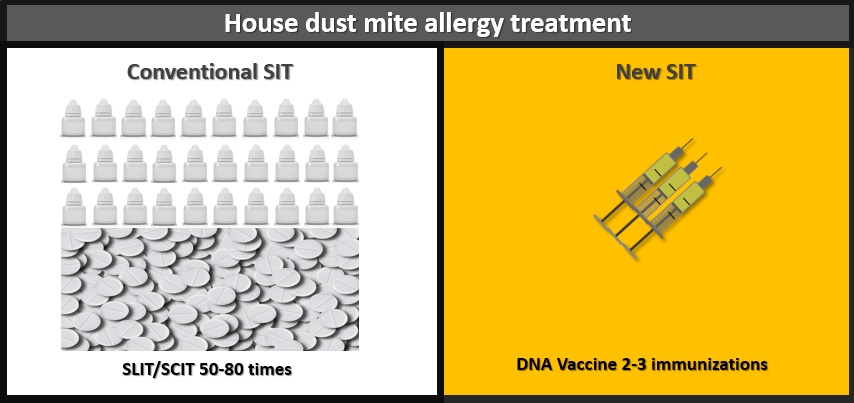
Because of these above disadvantages, innovative and more effective therapies are urgently required. Thanks to the great advances in molecular allergology and immunology, new anti-allergy vaccines are currently developed to treat HDM allergy and asthma.
House Dust Mite Vaccine
Since it was postulated that DNA immunization could preferentially induce Th1 responses and also, as demonstrated recently, tolerance, we developed DNA vaccines encoding major HDM allergens. Highly purified endotoxin-free DNA preparation can be easily obtained with reproducibility and at low cost. DNA vaccines are moreover highly stable and consequently do not need cold chain for their storage. Following DNA vaccine administration, the expressed allergen by transfected cells can be taken up by antigen presenting cells (DCs mainly) to elicit potent Th1-biased allergen specific response.
We clearly demonstrated that vaccinations with a DNA plasmid encoding the major HDM allergen Der p 2 and delivered in-vivo by electroporation prevent the development of HDM allergy in mice. We currently evaluate therapeutic vaccinations in pre-sensitized animals. As, it is well accepted that heterologous prime–boost is more effective than the ‘homologous’ prime–boost approach, we will also combine recombinant Der p 2 protein with specific pro-Th1 adjuvants in such vaccination protocols.
We believe that the consistent preclinical results generated from this research will allow to conduct rapidly clinical trials.
Immunol Lett. 2013 Mar;151(1-2):23-30
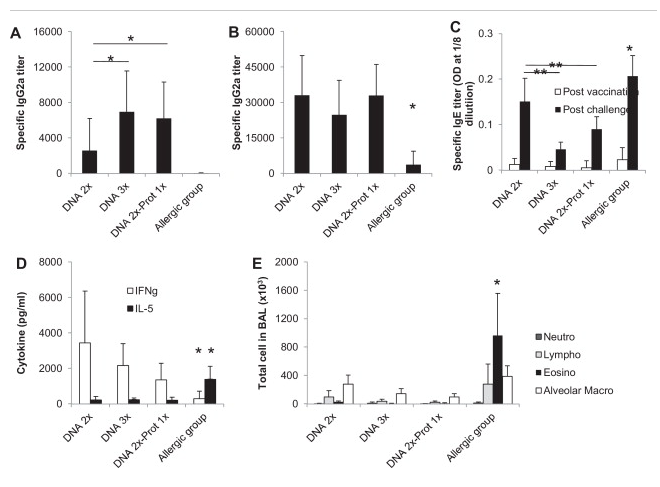
Aiming at developing a safer, hypoallergenic and more efficient prophylactic or therapeutic vaccine against house dust mite (HDM) allergy, we designed a virus-like particle (VLP) displaying multi-copies of the major HDM allergen Der p 2 using the SpyCatcher/SpyTag conjugation system.

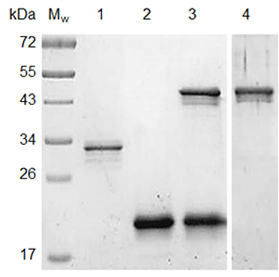
1: SpyCatcher-VLP; 2: rDer p 2; 3: Conjugation VLP with rDer p 2; 4: Purified VLP-rDer p 2
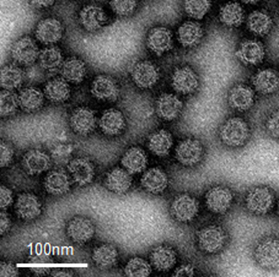
Transmission electron microscopy confirmed the presence of uniform and non-aggregated VLP-rDer p 2
Allergy. 2020;75(5):1232-6.
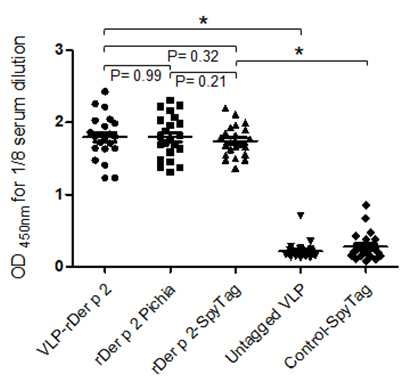
VLP-rDer p 2 and the two monomeric forms of rDer p 2 shared similar IgE‐binding capacities
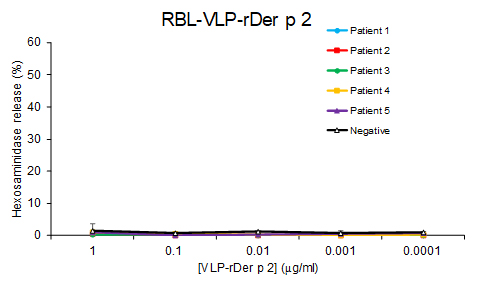
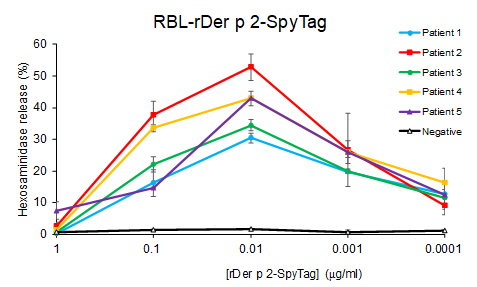
Whereas particulate VLP-rDer p 2 failed to trigger basophil degranulation, rDer p 2-SpyTag induced allergen concentration-dependent mediator release.
Allergy. 2020;75(5):1232-6.
The efficacy of prophylactic vaccinations with VLP-rDer p 2 was evaluated in a Der p 2 sensitization mouse model. ALB/C mice were intramuscularly vaccinated three times at two weeks interval with unadjuvanted VLP-rDer p 2 or monomeric rDer p 2-SpyTag mixed with untagged AP205 VLPs. As controls, mice were administrated with saline alone. Vaccinated mice were subsequently sensitized intraperitoneally by rDer p 2/alum (1/100 antigen/alum ratio) and challenged by five consecutive intranasal administrations of HDM allergen extracts to trigger airway inflammation
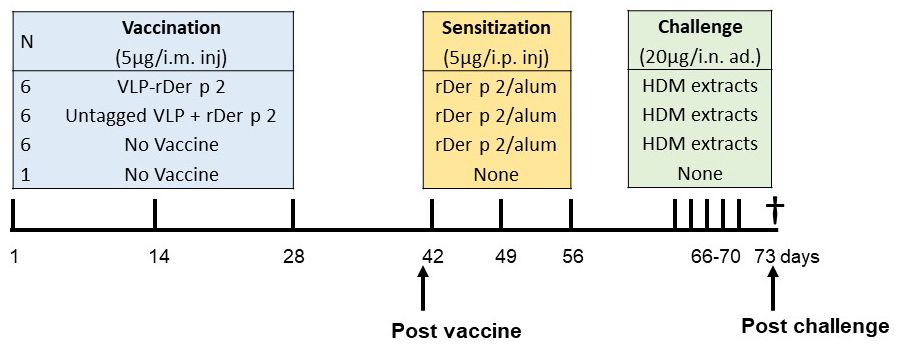
Allergy. 2020;75(5):1232-6.
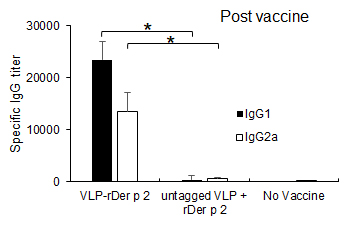
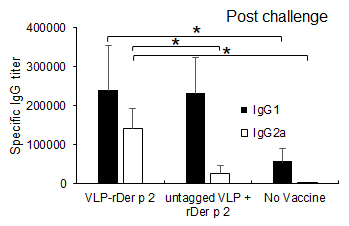
Vaccinations with unadjuvanted VLP-rDer p 2 induced significantly stronger antibody responses compared to monomeric rDer p 2 mixed with untagged, although with comparable specific IgG2a/IgG1 ratio. ELISA IgE and RBL-2H3 degranulation assays did not evidence the development of specific IgE with VLP-rDer p 2 or rDer p 2 mixed with untagged VLP. The subsequent Der p 2 sensitizations and intranasal challenges were shown to significantly boost the specific IgG1 or IgG2a titers in both groups of vaccinated mice. Whereas a ten-fold increase in antibody response did not modulate the specific IgG2a/IgG1 ratio generated by VLP-rDer p 2, the specific IgG2a/IgG1 ratio in untagged VLP + rDer p 2-SpyTag-vaccinated mice drastically dropped due to a huge boost in specific IgG1 titers.
Allergy. 2020; 75(5): 1232-6.
ELISA IgE
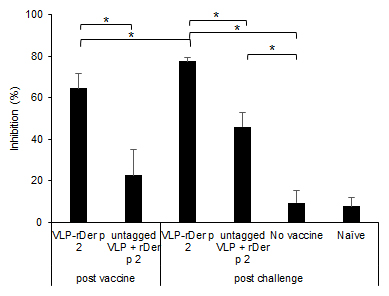
RBL assay
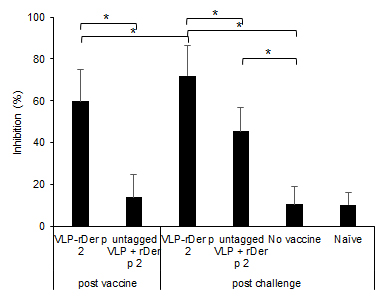
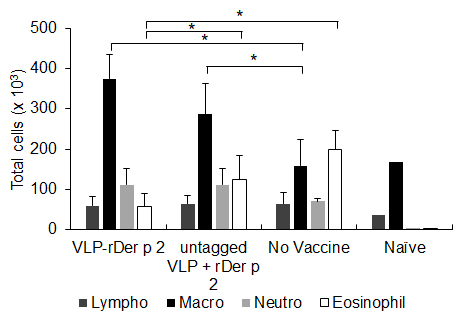
Competitive ELISA and RBL-SX38 assays evidenced that VLP-rDer p 2-induced IgG antibodies were able to inhibit the binding of human specific IgE to solid-phase rDer p 2 and to suppress the allergen-induced degranulation of preloaded RBL cells by up to 65%. Such degree of inhibition reached up to 77% following the sensitization and the challenge of vaccinated mice. Finally, levels of IL-5 secretion commonly observed in allergic mice could be similarly detected in restimulated spleen cells from both vaccinated groups (P > 0.05). Strikingly, only the splenocytes from mice vaccinated with VLP-rDer p 2 could release IFNg (400 +/- 200 pg/ml, P < 0.05). Vaccinations with VLP plus monomeric rDer p 2 did not modulate typical BAL eosinophilia observed in allergic mice. In contrast, vaccination with VLP-rDer p 2 was shown to significantly decrease the accumulation of eosinophils by more than 70 % (P < 0.05) (Figure 2F). Significant increase of alveolar macrophage influx was measured in the airways of both vaccinated groups (P < 0.05) as compared with the allergic control groups.
Allergy. 2020;75(5):1232-6.

